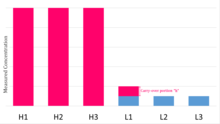Automated analyzers, employing robotic pipetting and cuvette washing systems, are the standard means for processing patient specimens in clinical chemistry or haematology laboratory. The pipetting and washing systems are designed to continuously sample patient specimens and clean sample probes and reaction cuvettes or vessels. An obvious concern is the potential for carryover of analyte from one patient specimen into one or more following patient specimens, which can falsely increase or decrease the measured analyte concentration. Specimen carryover is typically addressed by judicious choice of probe material, probe design, and an efficient probe washing system to flush the probe of residual patient specimen or reagents retained in their bores or clinging to the probe exterior surface before they are introduced into the next patient sample, reagent container, or cuvette/reaction vessel.

Significance in carryover assessment
editSome measurand analyzed by automated analyzer might have very high pathological range (eg: Sex hormone, Tumor marker, Troponin...etc.). Very small portion of carryover might not be acceptable and led to misdiagnosis.
Carryover assessment
editIUPAC made a recommendation in 1991[1] for the description and measurement of carryover effects in clinical chemistry. The carryover ratio is the percentage of H3 carry to L1 constituting the carryover portion "h". In a design of 3 high samples followed by 3 low samples, h can be calculated as (L1 - mean of L2&L3) / (H3 - mean of L2&L3)
The acceptance criteria for carryover ratio would depends on the measurand. For example, 1% carryover of plasma albumin would generally acceptable while 1% carryover of cardiac High sensitivity Troponin assay would be totally unacceptable.
- ^ Haeckel, R. (1991-01-01). "Proposals for the description and measurement of carry-over effects in clinical chemistry (Recommendations 1991)". Pure and Applied Chemistry. 63 (2): 301–306. doi:10.1351/pac199163020301. ISSN 0033-4545.
